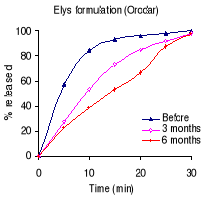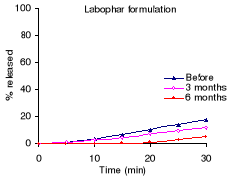7.2.2 Results
The RSD was 0.68 % within a day and 1.57 % within three days,
which complies with the USP 24 requirements (RSD should be less than 2.5 %).
The resolution between sulfadoxine and phenacetin and between pyrimethamine and
phenacetin was 2.3 and 1.9, respectively, which means that those three
compounds were well separated.
The sulfadoxine and pyrimethamine contents for each
formulation (Table 7.1) were within the USP 24 requirements (90 - 110 % of the
labelled amount of both sulfadoxine and pyrimethamine). The stability test
conditions did not affect the formulations because the drug content did not
show significant change.
Table 7.1 The sulfadoxine and pyrimethamine
content (expressed as percentage of the labelled amount) before and after 6
months of storage at 40°C and 75 % RH.
Manufacturer %
of the labelled amount per tablet
0
months 6 months
Sulfadoxine
Elys Chemicals (Orodar) 105.3
103.4
Labophar 100.0
98.9
Pyrimethamine
Elys Chemicals (Orodar) 105.5
101.5
Labophar 90.9
90.3
II.7.3 In vitro dissolution
7.3.1 Methods
· Preparation of dissolution
medium
68 g of monobasic potassium phosphate was accurately weighed
and dissolved in about 9 L of distilled water. The pH was adjusted to 6.8 using
a 2 N sodium hydroxide solution and distilled water was added to 10.0 L.
· Calibration curves of sulfadoxine and
Pyrimethamine
Using the HPLC method, the calibration curves mentioned in
quantitative drug analysis were used for calculation of the amount of drug
released. The same mobile phase, the same standard solutions and the same
concentrations were used.
· Dissolution testing
Dissolution profiles were determined using the USP paddle
method (Method 2). Each of 6 tablets was placed inside a dissolution vessel
filled with 900ml of dissolution medium maintained at 370.5°C and stirred
by paddles rotated at 75 rpm. At 5, 10, 15, 20, 25 and 30 min 5 ml samples were
withdrawn, filtered, diluted 3 times and analyzed for their contents of
sulfadoxine and pyrimethamine by UV at 254 nm after chromatographic
separation.
Procedure
20 ul of each of the collected samples was injected onto the
HPLC system and corresponding peak areas were recorded.
The content of each sample was calculated based on the
calibration curves.
7.3.2 Results
Table 7.2 shows the percentage drug dissolved and Figures 7.1
and 7.2 the dissolution profiles of the different formulations analyzed.
Before stability testing, all formulations complied with the
USP 24 requirements for sulfadoxine: not less than 60% of the sulfadoxine and
pyrimethamine labelled amount should dissolve within 30 minutes. For
pyrimethamine, the Labophar formulation failed (only 18 % was released within
30 minutes). Tablets from Labophar took about 10 minutes to disintegrate which
delayed the dissolution.
Upon stability testing (storage at 40°C, 75 % RH), the
Elys formulation (Orodar) remained within the USP 24 requirements for in vitro
drug release. The tablets from Labophar did not disintegrate completely within
the interval time.
Table 7.2 Percentage of sulfadoxine and
pyrimethamine dissolved within 30 minutes of dissolution testing before and
after 3 and 6 months of storage at 40°C and 75% RH. USP requirements: more
than 60 % released within 30 minutes.
Manufacturer
% of the labelled amount per tablet
0
months 3 months 6 months
Sulfadoxine
Elys Chemicals (Orodar) 100.0
97.7 97.0
Labophar 90.7
67.6 44.4
Pyrimethamine
Elys Chemicals (Orodar) 90.4
79.2 78.0
Labophar 17.8
11.9 4.9
Figure 7.1 Dissolution profiles of sulfadoxine before and
after 3 and 6 months of storage at 40° C and 75 % RH.


Figure 7.2 Dissolution profiles of pyrimethamine before and
after 3 and 6 months of storage at 40° C and 75 % RH.


| 


